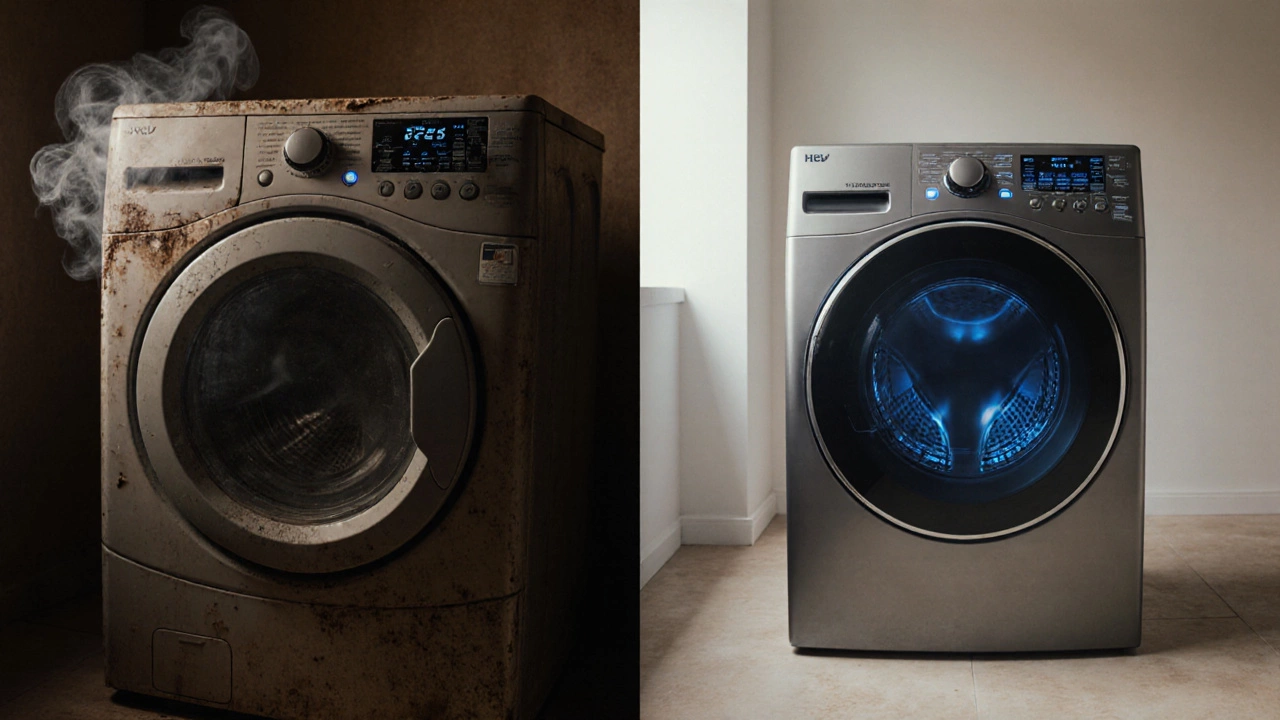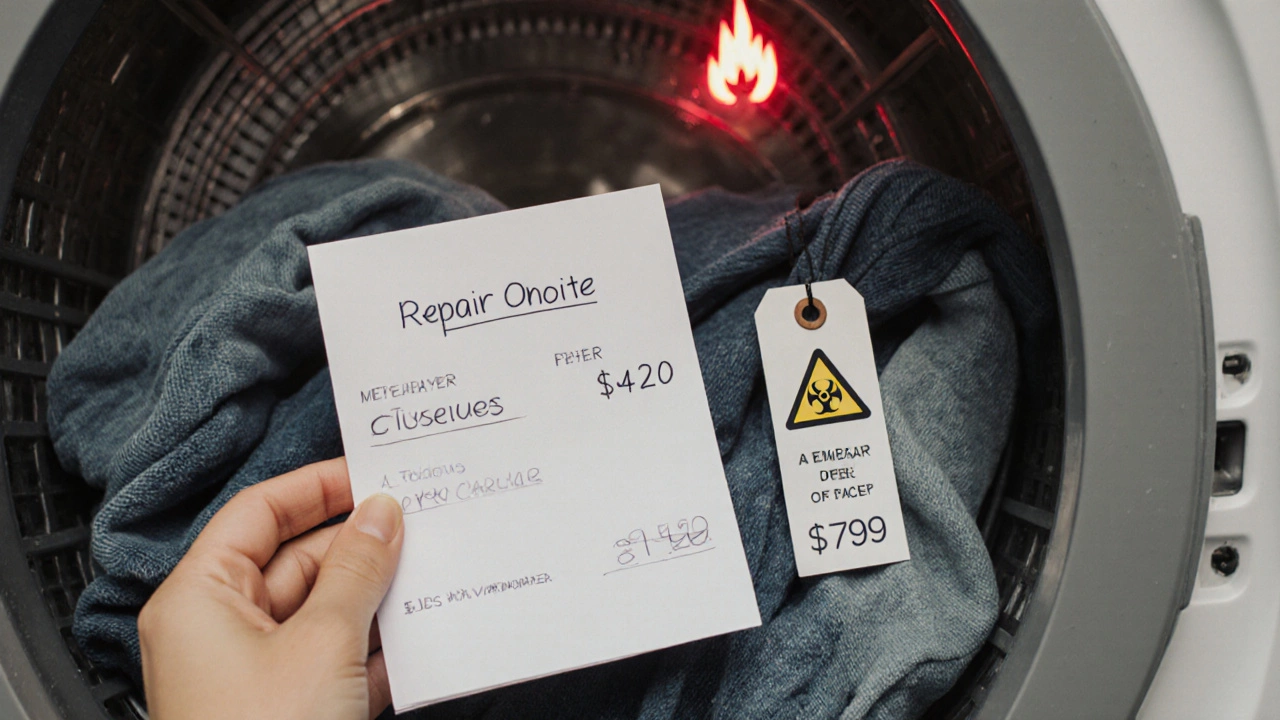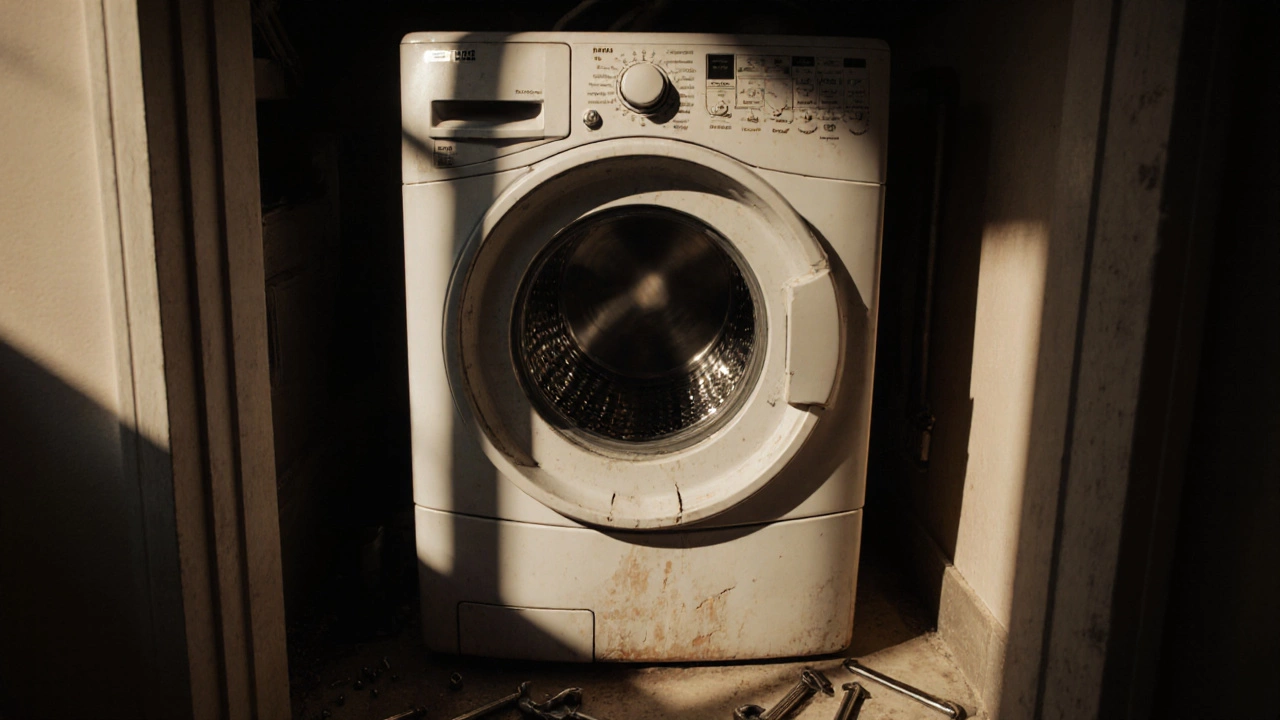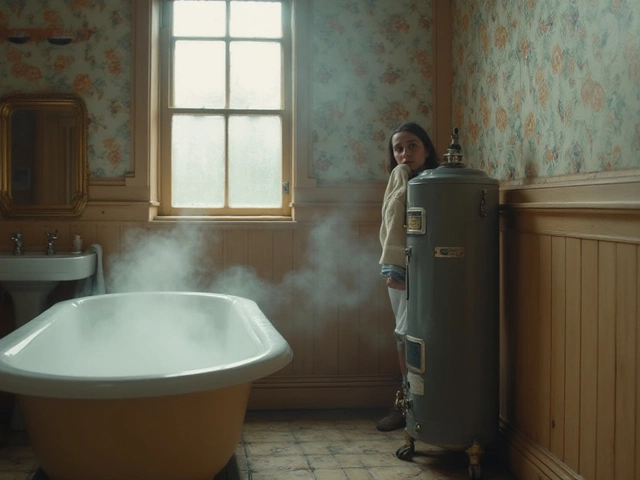Tumble Dryer Repair vs Replacement Calculator
Dryer Information
Your Recommendation
Key Decision Factors
Most people try to fix their tumble dryer the second it stops working. You unplug it, Google the error code, watch a YouTube video, and spend an afternoon tinkering. But sometimes, no amount of screwdrivers or YouTube tutorials will bring it back-and trying to fix it just costs more time, money, and frustration.
It’s older than your oldest pair of jeans
If your tumble dryer is over 10 years old, repair isn’t just a cost-it’s a gamble. Modern dryers are built with smarter sensors, better energy ratings, and quieter motors. A 12-year-old dryer might have cost $600 when you bought it. Today, you can get a new one with heat pump technology for under $900, using nearly half the electricity. Repairing a decade-old machine often means replacing a $150 drum bearing, only to have the heating element fail six months later. That’s not a repair. That’s throwing good money after bad.Manufacturers don’t design dryers to last forever. The average lifespan is 10-13 years. After that, parts become harder to find, and labor costs rise because technicians have to dig through old stock or order custom components. If your dryer is 10+ years old and needs more than a simple belt or fuse replacement, walk away.
The repair quote is more than half the cost of a new one
This is the simplest rule: if the repair estimate is more than 50% of what a new dryer costs, buy new. It’s not a suggestion-it’s a hard financial line.Let’s say your dryer is a mid-range model. A new one runs $750-$900. If a technician says it’ll cost $450 to replace the thermal fuse, motor, and drum rollers, that’s 60% of the price of a brand-new unit. You’re paying almost as much for a machine that’s already worn out. New dryers come with at least a 12-month warranty. Repaired ones? You get a 30-day guarantee on the part, if you’re lucky.
And here’s the kicker: older dryers use more power. A 12-year-old model can use 5-7 kWh per load. A new heat pump dryer uses 1.5-2 kWh. That’s a $150-$200 annual saving on electricity. In two years, you’ve paid for the new machine-and you’re still saving.
It’s making strange noises you can’t ignore
Not all noises are equal. A light rattle? Probably just a loose screw. A loud grinding, screeching, or thumping? That’s the drum bearings failing-or worse, the motor seizing. These aren’t minor fixes. Replacing drum bearings means taking the entire dryer apart, removing the drum, and installing new rollers. Labor alone can hit $200-$300. Add parts, and you’re at $400+And even after that repair, the drum might be warped from years of imbalance. The motor might be running hot. The belt might be stretched. You’re patching a system that’s already fatigued. If your dryer sounds like a jet engine starting up, it’s not just annoying-it’s a sign of internal wear that’s likely to get worse fast.
It’s not drying clothes properly anymore
If your clothes are still damp after a full cycle, you might blame the load size or the lint filter. But if you’ve cleaned the filter, checked the vent, and tried different settings-and it still doesn’t dry-something deeper is wrong.The heating element could be failing. The thermostat might be stuck. The airflow could be blocked internally. But here’s what most people don’t realize: if the dryer can’t generate enough heat or move air efficiently, it’s not just inconvenient. It’s dangerous. Damp clothes sitting in the drum too long breed mold. Overworked heating elements can overheat and spark. And if your vent is clogged with lint (which happens faster when the dryer struggles), you’re one spark away from a fire.
Modern dryers have multiple safety sensors that shut them down before things get dangerous. Older models? They don’t. If your dryer is struggling to dry, it’s working harder than it should-and that’s a red flag.

The control panel is glitchy or dead
A cracked button or a flickering display? Easy fix. But if the whole control panel is unresponsive, or it’s showing random error codes that don’t match any manual, you’re dealing with a failed main control board. These boards are expensive-$150-$300-and often not available for older models. Even if you find one, it might not be compatible with your machine’s firmware.And here’s the truth: control boards don’t fail for no reason. They die because the dryer’s internal electrical system is stressed. That stress comes from aging components, voltage fluctuations, or moisture damage. Replacing the board doesn’t fix the root problem-it just delays the next failure.
Think of it like replacing the motherboard in a 10-year-old laptop. You might get it working again, but the battery’s swollen, the fan’s noisy, and the screen flickers. You’re not restoring it-you’re keeping a relic alive.
It’s been repaired before-and now it’s broken again
If your dryer has been fixed twice in the last three years, it’s not broken. It’s dying. Every repair puts stress on other parts. A new motor strains the belt. A new drum bearing puts pressure on the shaft. A new heating element draws more current, stressing the wiring.It’s like fixing a car with a blown head gasket, then replacing the radiator, then the water pump. The car runs for a while, but the engine block is cracked. You’re just buying time.
When a dryer keeps failing after repairs, it’s telling you something: its core components are worn out. No single part is the villain. The whole system is exhausted. At this point, replacement isn’t just smarter-it’s safer.
The dryer smells like burning plastic or overheating
That smell? It’s not lint. It’s insulation melting. It’s wiring fraying. It’s plastic components warping under too much heat. This isn’t a warning sign. This is an emergency.Some people think, “It’s just a little smell. I’ll keep using it.” But dryers operate at temperatures over 150°C. If plastic is melting, the insulation around wires is breaking down. That’s how fires start. The National Fire Protection Association reports that over 2,900 home fires each year in the U.S. are caused by clothes dryers. Most are linked to faulty wiring, overheating motors, or blocked vents in aging machines.
If you smell burning plastic, turn it off. Unplug it. Don’t use it again. No repair is worth risking your home.

It’s not energy efficient anymore
If your dryer is pre-2015, it’s probably using 5-7 kWh per load. A new heat pump dryer uses 1.5-2 kWh. That’s a 65-75% drop in energy use. In Adelaide, where electricity costs around 30 cents per kWh, that’s $1.50-$2.10 per load versus $0.45-$0.60.Do the math: if you dry five loads a week, you’re spending $39-$55 a month on electricity with an old dryer. With a new one? $12-$16. That’s $300+ saved per year. Even if you spend $800 on a new heat pump dryer, you’ll break even in under three years. After that? Pure savings.
Plus, new dryers have moisture sensors that stop the cycle when clothes are dry. Old ones just run for a set time-wasting energy on clothes that are already dry.
What to do instead
If your dryer hits any of these red flags, don’t repair it. Replace it. Look for models with:- Heat pump technology (most energy efficient)
- Moisture sensors
- At least a 2-year warranty
- Quiet operation (under 65 decibels)
- Compatible with your space (size, venting, power outlet)
Don’t buy the cheapest one. Don’t buy the most expensive one. Buy the one that fits your usage. If you do two loads a week, a compact 7kg heat pump dryer is plenty. If you have a family of four, go for an 8-9kg model with steam refresh.
And if you’re unsure? Ask a technician to give you a written quote for repair versus a quote for a new unit. Compare them side by side. You’ll almost always see the same thing: repair costs creep up, while new dryer prices stay steady-and efficiency keeps improving.
Final thought
Tumble dryers aren’t like refrigerators or washing machines. They run hot, spin fast, and are under constant stress. They’re designed to last, but not forever. When they start failing in multiple ways, it’s not a coincidence. It’s the end of the line.Repairing a dryer past its prime doesn’t save money. It delays the inevitable-and increases risk. Replacing it isn’t giving up. It’s choosing safety, efficiency, and peace of mind.
Is it worth repairing a 10-year-old tumble dryer?
Generally, no. A 10-year-old dryer is at the end of its lifespan. Repairs cost more than 50% of a new unit’s price, and parts are harder to find. Even if it works after repair, other components are likely to fail soon. Energy efficiency also drops significantly after 10 years, meaning higher electricity bills.
How much should I spend on a dryer repair before replacing it?
If the repair quote is more than half the price of a new dryer, walk away. For example, if a new dryer costs $800, don’t spend more than $400 on repairs. Beyond that, you’re paying for a machine that’s already worn out. New dryers come with warranties and better efficiency, making them a smarter long-term investment.
Can a broken heating element be repaired?
Yes, a broken heating element can be replaced. But if your dryer is older than 8 years, replacing just the element often leads to another failure within months. The motor, thermostat, or drum bearings may also be worn. Replacing one part doesn’t fix the whole system’s age-related wear.
Why does my dryer smell like it’s burning?
A burning smell usually means plastic insulation is melting or wiring is overheating. This is dangerous. It can lead to a fire. Stop using the dryer immediately. Unplug it. Do not attempt to repair it yourself. Have it inspected by a professional or replace it. Older dryers are more prone to this issue due to degraded components.
Should I buy a heat pump dryer instead of repairing my old one?
Yes, especially if your old dryer uses more than 5 kWh per load. Heat pump dryers use 60-75% less energy, saving you $200-$300 a year on electricity. They’re also gentler on clothes and quieter. Even though they cost more upfront, the savings pay for themselves in 2-3 years. Plus, they’re safer and more reliable than aging vented dryers.







